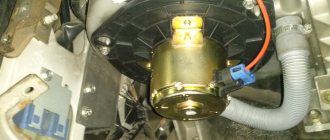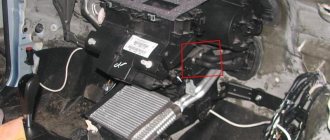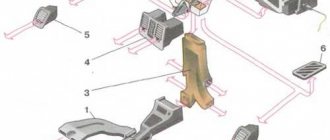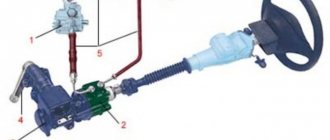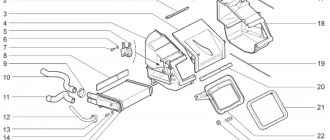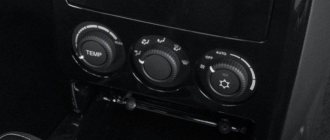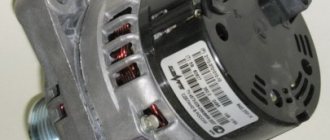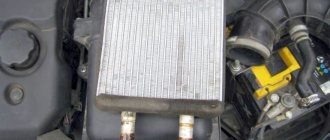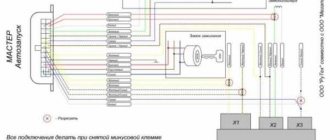In the winter months, you need to find out why the stove is not working and cold air is blowing on a Priora (or other domestically produced car) as quickly as possible. Of course, you won’t turn into ice and don’t risk freezing anything. But driving with the heating not working is, at a minimum, unpleasant and fraught with all sorts of colds.
And driving out onto the highway is completely dangerous: God forbid, something breaks, you will really freeze until help arrives. Priora is the generally recognized descendant and successor of the Lada “ten”.
And the manufacturer did not make any fundamental design changes to the stove; only individual elements were changed. Accordingly, the diseases inherent in the ancestor were inherited by the descendant. All Priora owners unanimously assure that the heating system in it is very unreliable and can break down in several components. The worst thing is that in the summer few people remember about the stove and are puzzled by checking it. Therefore, discomfort is detected suddenly and requires lightning-fast action.
Why doesn't the heater work and blows cold air on the Priora? There are many reasons for this. In descending order of frequency of cases, they can be arranged as follows:
- The stove damper is stuck. It does not open and does not allow warm air into the cabin. By the way, the opposite option is also possible: if it is closed in the open position, you begin to feel like you are in a sauna;
- The heating gear motor is broken;
- The stove control unit does not work;
- Problems in the engine cooling system;
- The temperature sensor in the cabin has broken down, and the heating system simply does not know that you are cold. Again, in a similar but opposite case, it may be hot.
Clogged filter
Experienced Prior owners have developed an algorithm of actions to find out where the heating system is leaking.
First approach
Before all checks, you need to make sure that the fan is working - it would be unreasonable to go deeper if the main element does not spin. The next steps are as follows.
- The engine heats up to the desired temperature;
- The pipes leading to the heater are probed. Both are hot - okay, one is at ambient temperature - which means there is no filler circulation;
- The hood opens, the tap is located and turns to another position. If it has become stuck, you will have to soak it immediately.
- The system is checked for leaks. The detected ones are eliminated: a constant lack of coolant is also the cause of cold airflow;
- The tap is working, there is no leak - the plug is removed from the tank and the liquid level is checked. Often an air lock forms in the tank; in this case, the coolant is topped up to normal, and the gas pedal is pressed sharply several times. The fluid circulation will resume and squeeze the plug out of the reservoir;
- To make the last step more effective, it is better to drive the front end onto the nearest hillock so that the car’s radiator is lower than the stove radiator.
Second approach
When (or if) both pipes are filled with hot liquid, we move on to the dampers.
- Again you will have to climb under the hood, this time to observe the operation of the damper;
- If it is warped or jammed, you can try to gently shake it with your hand from inside the cabin. To do this, remove the central deflector and unscrew the plastic guides to reach the stuck element. Access is only possible for a thin limb, so it is advisable to invite a female person to the procedure if she does not mind;
- If there are serious problems with the damper (the fastenings have rusted, the plastic has warped due to temperature or it has cracked), alas, you will be faced with difficult work: you will have to disassemble half of the heating system.
Third approach
The microreducer is a complete headache. First, its status is checked:
- The left handle is moved to the “min” position. After a 15-second wait, the engine starts;
- The controller that monitors the self-propelled guns is disconnected;
- The tester measures readings
on both contacts. The resistance should be 800-1200 Ohms for units 1303.3854; 1313.3854 and 1333.3854; for controller 1323.3854 the norm is 3600-5000; - The same operation is carried out in the “max” position. Now the data is in the range of 3200-3500 for the first group and 1200-1600 for 1323.3854;
- If there is no resistance or its unchangeability, the track on the sensor has been erased. It is not sold separately, so you will have to change the entire MMR. It is clear that not all the reasons why the stove does not work and cold air blows on a Priora can be eliminated on your own.
However, by following the above recommendations, you will at least understand what is preventing you from driving comfortably.
And also estimate upcoming expenses. For example, if you have to change the entire SAUO unit, you will have to pay about 1.5 thousand rubles for it. plus the work of an electrician. The Lada Priora car enjoys the well-deserved love and respect of our compatriots. A good price-quality ratio, the abundance of spare parts and excellent maintainability make it a leader in the domestic market. However, being the result of Russian development, this car also has some disadvantages.
As you know, Priora is a deep restyling of the previous model - the 2110th. Therefore, most components and assemblies moved from the “ten”, including the design of the heating and ventilation systems for the interior. Most of the main parts of this system are “decimals”.
Therefore, such unification is very helpful during repairs. Unfortunately, this feature backfires when malfunctions occur. There are quite frequent cases when the stove on a Priora does not work. The situations are different. In one case there may be problems with the fan, in another - with the dampers, etc.
Preparatory stage
Troubleshooting the heater should begin provided that the power unit and engine cooling system are in order to eliminate their influence. To do this, you need to make sure that the antifreeze is poured in the proper amount, the engine is in good condition and is functioning normally. And after that, find out why the stove on the Priora does not work. First, check the coolant level in the expansion tank. Next, you need to start the engine and warm it up to operating temperature. After this, you need to check the serviceability of the thermostat - feel the thick hoses that go from it to the car radiator.
The top one should gradually become hot. If the rubber hose is still cold, the thermostat is faulty. In this case, you can continue working only after replacing this element. Fortunately, its cost is low.
Another reason why the engine may not warm up to operating temperature is a leaky expansion tank cap. It should keep excess pressure in the system. Often, simply replacing this cover can completely eliminate the problem.
On the Priora, unlike the Tens, the cooling system is organized differently. And the formation of an air lock there is practically excluded. It can occur when the system is leaking or when antifreeze is poured into a completely empty expansion tank. This can be fixed quite simply. You need to drive your front wheels up some hill in a warm car and vigorously apply the gas in place. The expansion tank cap should be removed.
Heater device on Priora
The liquid-type heating system on the Lada Priora is structurally connected to the engine cooling system and includes:
- radiator or heat exchanger of the heating system;
- a fan supplying air to the cabin;
- damper that regulates air temperature;
- heater damper reducer;
- damper for flow distribution on deflectors;
- deflectors.
A failed heater damper on a Priora does not close completely, so the warm flow mixes with cold air without warming up to the required temperature and the cabin is always cool and uncomfortable. To fix the problem, you need to remove, replace or repair the heater damper gear motor.
Heater radiator malfunctions
Another reason why the deflectors in a Lada Priora car do not work may be the accumulation of dirt in the heat exchanger. When the cooling system operates, deposits accumulate in the engine block itself over time, which are then spread throughout the entire system, including into the heater radiator. These deposits prevent it from working effectively. The system will heat the air worse. In this case, the heater radiator can be replaced entirely. It is removed from the engine side. Before starting work, be sure to drain the antifreeze from the cooling system. Then dismantle the windshield wiper arms, the frill trim and move aside part of the soundproofing shield. After this, disassemble the stove body, disconnect the wires, remove the fan motor along with the impeller and remove the heat exchanger, disconnecting the supply hoses from it.
How to replace the radiator of a Priora stove with air conditioning
A failed stove in winter is a very serious problem for the owner of any car, including the Lada Priora. It should immediately be noted that there can be many reasons why a breakdown occurred. Sometimes it will take very little time to eliminate them, but in some cases you will have to tinker. However, often there is nothing particularly complicated in such work, and it is quite possible to do it yourself, even if you have never done anything like this before.
How to replace the heater radiator of a Lada Priora with air conditioning
As mentioned above, there can be many reasons why warm air has stopped flowing into the cabin while the heater is on. First, let's briefly look at the design features of the Priora heating system, as well as its main elements. There are no particularly complex electronic devices here - everything is done quite simply, and therefore reliably. The stove on the VAZ-2170 is of a liquid design, and it is combined with the engine cooling system. In fact, here is a classic scheme where antifreeze is heated and warm air is supplied to the car interior. The main elements of the system are:
- radiator;
- fan;
- 2 dampers, with which you can regulate the strength of the flow of warm air and its distribution among the zones of the cabin.
For those who have previously had to deal with the heating systems of VAZ cars, there is essentially nothing new here. The coolant is heated in the radiator, after which the warm air is blown into the passenger compartment by a fan. The driver is able to regulate the intensity of the flow, as well as distribute it throughout the cabin.
It should also be noted that Priora can be found in two different trim levels - with and without air conditioning. In the first case, VAZ installs devices from Panasonic or HALLA on the model 2170. At the same time, cars with air conditioning turned out to be more convenient in terms of maintenance and repair of the heating system, since access to its components was significantly simplified.
In particular, in order to remove the radiator, it is no longer necessary to dismantle the decorative trim of the windshield. In addition, there is no need to remove the wiper arms. There is also no need to remove the brake booster and heater. All this saves a lot of time; accordingly, all the necessary work can be done faster than on a Priora without air conditioning. Yes, there shouldn’t be any difficulties with this.
In order to remove the heater radiator on a Priora with air conditioning, you will need a minimum set of tools. In particular, you should take:
- wrenches - 8, 10 and 13;
- Phillips screwdriver;
- container for draining coolant.
Having prepared everything you need, you can start working.
The first step is to remove the rubber seal from the windshield trim - this is necessary in order to gain access to the components we need. The next stage is dismantling the middle part of the engine compartment sound insulation. To do this, you must first remove the hoses from the mounts. It should be noted that in the upper part the sound insulation in the Priora engine compartment is held in place by 3 self-tapping screws, in the lower part by 3 screws, 2 nuts and a washer. Some of the mounts are quite difficult to reach, so it is recommended to use special tool extensions.
After the middle part of the sound insulation is removed, you will see a foam rubber seal - it covers the stove radiator. To dismantle the cover, you will need to unscrew the 3 screws available here - 2 are located at the edges, the third is in the middle. As a result, we have already reached the pipes - they will also need to be removed. To do this, you must first loosen the clamps holding them. After this, you need to carefully, without tilting the hoses down, pull the pipes up. That's all - all that remains is to pull the heater radiator towards you. This also needs to be done quite carefully, without making serious efforts. Pull the radiator towards you until it comes out of the corresponding fasteners.
It should be noted that it is not necessary to drain the coolant when performing such work in a Priora with air conditioning. Antifreeze will only come out of the expansion tank, and a very small part of it will come directly from the radiator itself. It was said above that the Prior family is equipped with air conditioners from different manufacturers, but this point does not in any way affect the sequence of actions when removing the heat exchanger. The differences here are quite insignificant - only in the number of fasteners. Well, the work itself, as you can see, is very simple. You should not have any particular difficulties when removing the heater radiator. If you are doing this kind of work for the first time, just take your time and remember to be careful.
Problems with the damper gear motor or fan motor
A common malfunction on a Lada Priora car is that the heater does not work. No air blowing at all.
First, you should make sure that it works - at least cold air should be blowing from the deflectors. If not, then you need to check the integrity of fuse F9.
If it is intact, it means the stove fan is not working. "Priora" is equipped with a "ten" fan. Therefore, removing it exactly repeats the procedure on the “ten”. In some cases, the fan does not spin because leaves or other foreign objects have gotten between the impeller and its housing, which can block rotation. In this case, you can hear a characteristic hum.
Cold air can also come out of the deflectors because the gear motor that controls the damper that blocks the flow of hot air is not working. It is also accessible from under the hood.
Often the cause of gearmotor failure is oxidation of conductive contacts. They need to be cleaned with sandpaper by disassembling the body. You should also pay attention to the strength of the air flow. If even at maximum speed the air is blowing weakly, it may be a clogged cabin filter. It is located under the hood in the heater housing and creates additional interference.
Life hack: gear motor and other components of the Priora car heater
If the windshield of a Lada Priora car is fogged up and looks as if it was smeared with greasy hands after eating pirazhki - driver, beware, your heater is leaking! Maintaining normal temperature in the cabin at different times of the year is necessary in order to feel comfortable behind the wheel. In winter, the stove on the Priora saves you from freezing, which provides the heat a person needs. But you need to take care of it and prepare it for winter in the summer, because being left without heating in winter is not the greatest pleasure. The sore spots in the system that break down more often than others are the gear motor and the heater damper. Priora is a warm car - the original DAAZ is very good, it warms, and is warm in winter, because its radiator has the correct structure and fluid circulates inside. If you install the Chinese Luzar, you will freeze at -20 - I checked it personally. I put this luzar on, then took it off. The heater radiator is available for cars with and without air conditioning. The structure of the node is slightly different.
Additional resistance fault
There are often situations when the heater switch on a Priora does not work - the motor operates only at fourth speed or only at first. The reason here may be additional resistance, which slows down the rotation speed of the stove fan.
This resistance is a block of resistors (the fourth speed is direct, without deceleration). It is located in the heater housing on the left side and is secured with two screws. This resistance is also unified with many domestic models (2110, Kalina, Chevrolet Niva).
Malfunctions
For normal operation, the heating system needs: tightness, integrity of parts and normal antifreeze. The first step is to check the relay and fuse - after all, this unit contains electrical appliances inside. If the unit's electrical network is not in contact with the ECU, there is no point in turning the controls on the heater control unit.
The heater fuse on Priora has the number F9. In order to get to it, you need to remove the plastic plug above the driver's left knee (under the headlight switch) by unscrewing three bolts around its perimeter.
Malfunctions of the heater control unit
The operation of the heating system is completely dependent on it distributing air flows, the intensity of airflow to various zones of the cabin and the temperature regime. If it fails, the stove naturally stops working.
There may be malfunctions of the switches (“twisters”). The malfunction of the control unit should be checked last, since this unit is electronic and can rarely be repaired. Therefore, to check it, it is advisable to temporarily replace it with one that is known to work, borrowing it from a friend or in a store with a deposit.
Features of the heater in a Priora with air conditioning
A common reason why the stove (Priora with air conditioning) does not work is the failure of the speed control unit (RFV), which is located on the heater housing under the hood. It regulates the intensity of the fan motor. If it fails, the stove stops functioning altogether or operates only at fourth speed.
The cause of the malfunction is often prolonged operation of the heater in recirculation mode (with the air damper closed) and, as a consequence, its overheating. Therefore, its performance should also be checked.
Possible reasons for cold air supply
A common situation is when cold air blows from the Priora stove; there may be more than one reason for this. It is in identifying the malfunction that the main problem lies. There may be several reasons why the stove on a Priora does not blow:
- A breakdown of the engine cooling system is the most common problem. This is where diagnostics should begin. In most cases, the stove on a Priora does not turn on precisely for this reason.
- Strongly, which should be replaced with a new one. This procedure should be performed every six months, without waiting for the moment when the stove starts blowing cold air.
- The stove on the Priora is not blowing well, possibly due to the damper, which may be stuck. It may not open completely, thus blocking the path of hot air flows.
- The problem may also lie in the gearmotor. It is necessary to check its functionality.
- If the stove on a Priora does not work as you would like, then you should pay attention to the control unit.
- The temperature sensor can also have a negative impact on the performance of the heating system. To determine this point, you will need to turn off the sensor and see how the heater behaves.
We carry out comprehensive diagnostics
Not so easy. Even experienced motorists cannot cope with this task quickly. To avoid doing such a large amount of work in vain, it is better to first diagnose the heating system. You must proceed as follows:
- We probe the channels through which the coolant flows to the heater. They should be warm when the stove is on. In addition, when pressing on the main rubber hoses, resistance should be felt. If resistance is not felt, the pump pump may be faulty. This mechanism is responsible for creating the pressure of fluid flows necessary for normal operation of the heater.
- A little secret that may be useful to Lada Priora owners: does the stove blow cold air for a long time and does not warm up as quickly as we would like? Then you can try filling coolant to the bottom mark in the tank. In this case, the liquid will warm up faster. If you practice this method, you will need to constantly check the coolant level.
- If it works, then we can talk about a problem in the bearing, which is located on the electric fan. This situation cannot be ignored, since in the future the fan may jam and repairs will take place on a much larger scale.
- Is the stove not working? Perhaps the problem is hidden in fuse F9 with a rating of 25 A. Its function is to protect the power electrical lines of the heater. A blown fuse must be replaced. If such a situation occurs with enviable consistency, then it is necessary to check all electrical circuits of the heater, the insulation of the windings on the fan and the presence of an overload in the power circuit.
No heating at idle
It is not for nothing that this issue has been submitted for separate consideration, since it worries many motorists and solving the problem can be much more difficult than one might expect. So, you have a Priora, the heater does not heat up at idle, although when the car is moving, the interior is heated in normal mode. Here you can also identify several possible reasons:
- Insufficient coolant level.
- Leaks that lead to a decrease in antifreeze levels.
- Availability .
If the first two problems can be easily diagnosed and eliminated, then with an air lock the situation is much more complicated. If you have ruled out the first two reasons and the Priora’s stove still does not heat up at idle, you need to eliminate the air lock. You must proceed as follows:
- We remove the screen from the engine.
- We lower the clamp, after which it is necessary to remove the heating tube for the throttle assembly. We choose any of the two.
- Unscrew the cap on the expansion tank. We place a clean rag on the neck and begin to blow into the expansion tank. The air supply should be carried out until coolant begins to pour out of the tube, which was previously removed.
- Immediately place the tube on the fitting and carefully tighten the clamp.
- Installing the screen.
If the option of blowing out the tank does not suit you, then you can go another way. We warm up the engine so that the pressure in the heating system increases. After some time, we turn off the car and remove the hose from the heating of the throttle assembly. In this case, there is no need to remove the cap from the tank. As a result of high pressure, coolant will be forced through the tube. All that remains is to place the tube on the fitting and tighten the clamp.
Now the Priora stove should not cause any difficulties; you know how to fix faults, as well as carry out diagnostics and identify the source of the problems. Let the heater in your car always turn on, work properly and provide comfort regardless of the weather outside.
Often Russian car enthusiasts who drive a Lada Priora complain that the heater is not working well, the vehicle interior is cool, and the car’s side and windshield windows are freezing. In order to understand why the stove on the Priora stopped working, let’s look at the design of the entire heating system on cars of this modification.
Now the cabin of 2170 will be warm
With the onset of cold weather, we discovered that the stove on the Priora had died. Previously, they replaced a leaking radiator .
The cause turned out to be a leaky heater core. They urgently began to look for a worthy replacement and bought DAAZ, the Dimitrovgrad Automotive Components Plant, which supplies products to the main LADA conveyor. The product is also protected from counterfeiting, just like self-respecting brands. Authentication is verified by erasing the protective strip under the sticker and verifying the code in one of three ways - via SMS, on a hotline, or on the website.
After waiting until it became relatively warm outside, I began the replacement. We remove the engine shield trim. Next, we disconnect the heater into two parts in order to pull it out. We take out the right (as we go) part of the heater. Next, drain the antifreeze and disconnect the left part of the heater. Unscrew two nuts with a 10mm wrench and one 8mm nut under the panel. You need a long collar with a head. Disconnect the stove pipes. We take out the left part of the heater. We take out the radiator. Unscrew 3 screws and take out the heater radiator. Let's put everything back together in reverse order. At the same time, I checked what pressure the expander cap holds.
The result is a working stove in the cabin. The radiator is also suitable for 2110-2112 (up to 2004).
You won’t be able to ride much in the cold season with a non-working stove, so repairing it won’t be shelved. If you don’t want to turn to specialists, but want to do everything yourself, then you will initially need to study the design of the Priora stove without air conditioning or with air conditioning, depending on the car model. The electrical circuit of the Priora heater also requires attention.
Priora interior heating system
The vehicle is equipped with a stove (heating system) with a climate control system that provides comfort while traveling in the car. They are designed to eliminate problems in the event of cold weather or other weather changes. No one will ask the question why the stove in the Priora does not work, neither the driver nor the passengers.
The car's climate control system includes:
- the stove itself (heater);
- stove fan device;
- temperature sensor in the cabin;
- air distributor housing;
- airways;
- deflectors (directing the flow of air masses).
The air flow from the stove is transmitted to the housing part of the air distributor, from where it is directed along air lines. Through the air ducts, the flow flows to the windshield grilles of the windshield and side windows, to the air mass flow guides in the center and side of the dashboard, as well as to the lower plane of the cabin to the floor pans on the bottom of the body. With the advent of frost, defects in the heating system appear, the most unpleasant of which is that the Lada Priora stove does not work and other malfunctions.
Options for upgrading the Lada Priora stove
The heating system of the Lada Priora simultaneously performs several functions - ventilation of the interior, heating it in the cold seasons and cooling in the summer. A malfunction of the heating system creates significant inconvenience for the driver and passengers. Accordingly, sooner or later, every car owner comes to the conclusion that it is necessary to modify the vehicle’s heater.
High-quality modernization of the stove includes several stages of work:
- Sealing the holes in the front panel of the torpedo air ducts;
- Modification of the oven damper of the machine;
- Improved rear seat heating and driver footwells with updated corrugated air ducts.
Such comprehensive improvements will maximally solve the problem of poor-quality heating of the Lada Priora’s interior. Any person can cope with the tasks, the main thing is to treat the work responsibly and purchase inexpensive consumables.
Initially, it is necessary to disassemble the instrument panel, dashboard and air ducts of the heating system. Next, the fasteners that hold the floor tunnel lining cover and ventilation pipes are unscrewed. The glove box is removed from the dashboard and the fasteners that hold the dashboard are unscrewed through it. After dismantling all fasteners, the panel can be removed from its standard seat. For ease of operation, it is advisable to dismantle it completely, first disconnecting the connectors.
The preparatory stage of work can be considered completed. Then you can proceed directly to sealing the cracks of the dashboard.
Sealing the holes in the front panel and oven damper
The problem of blowing side windows is eliminated by sealing the holes in the torpedo's air duct system. To carry out the work you will need to purchase silicone or modelin. Sealant is used to seal around the perimeter of the torpedo contact area and the mounting holes. In this way, the gaps through which air disperses are eliminated, which will significantly affect the temperature in the vehicle interior. Also, sealing the holes will improve the quality of blowing the side windows of the car.
The next stage of work is sealing the cracks in the stove body. The stove damper has a factory seal, however, it does not close the holes tightly enough. As a result, warm air, regardless of the position of the valve, does not pass where it should. To fix the problem, you need to remove the factory seal from the damper and treat the product using modelin and double-sided tape. The damper body is glued in the same way. Thus, the loss of warm air, which is directed towards the driver, towards his feet and onto the windshield, is eliminated.
There is one more large hole left that needs to be closed. The gap at the beginning of the channel for heating the driver's window must be sealed using polyurethane foam, since the modelin in this place will be ineffective.
Improved heating of the rear seats and driver's feet
Next, the ventilation of the stove in the area of the driver’s feet and rear seats of the vehicle should be improved. There are two options for solving the problem here.
The first method is to glue the plastic block of the air distributor with model. In another way, its driver is also called a Christmas tree. It also has holes through which air leaks. The result of the leak is a weak flow of warm air to the above locations.
The second option is the installation of corrugated tubes for high-quality air supply to the driver and passengers’ feet area. This option is more popular among vehicle owners. On the one hand, thanks to this modification, with the help of corrugated tubes it is possible to correctly supply air to the right place without loss, on the other hand, the corrugation will take up little space under the panel, which will facilitate access to the car's wiring. You need to start work by cutting down the Christmas tree. Old air distribution partitions must also be removed.
Next, three corrugated tubes are installed into the modified standard air distribution unit using polyurethane foam. The tubes must have a diameter of at least forty millimeters. When choosing tubes, pay attention to their inner surface. It should be smooth so that when you turn on the stove there is no noise or whistling in the car interior.
After the foam has dried, the updated air distribution unit with three corrugated tubes is installed in its original place. One tube is designed to heat the space under the dashboard in the area of the driver’s feet, the second is responsible for supplying air towards the front passenger’s feet, the last corrugation, the longest, is placed near the ashtray - to heat the rear seats. To place the third corrugated tube, it is important to dismantle the standard tunnel partitions.
Car heating system malfunctions
In a Lada Priora car, the heater regulator does not work due to a malfunction of the multi-position switch or a defect in the blower fan. When troubleshooting this problem, when the Priora stove fan does not work, you should look at the fuse box, which is the main source of trouble for the operation of the ventilation device. Many defects in a car's climate system are directly related to the operation of the vehicle's cooling system.
If the fan device is in good working order, but the stove on the Priora does not heat well, then the defect should be looked for by a sequential method of cutting off the tested elements. So, the stove on the Priora is not working well and the interior is quite cool:
First stage
: with the engine brought to the optimal temperature, we check the 2 pipes connected to the heater for temperature values. If both products are hot, then there is no circulation of air masses, and if one pipe is hot and the other is cold, then this indicates a lack of circulation of the aqueous solution in the system. We carry out diagnostics of the heater tap in order to deal with the cooling system solution (water, antifreeze).
For this purpose, open the hood and move the tap from one position to another. If there is a leak from the heating system, then it must be eliminated, because... an insufficient amount of coolant can provoke a situation where cold air blows from the Priora’s stove and the cabin becomes cool. If the tap is rusty and cannot be adjusted, you can leave it in this position during the summer when the heating system is not in use. Closer to cold weather it needs to be replaced.
Second phase
: when the tap is in the working position and the stove refuses to work, remove the filler plug of the radiator tank and check for the presence of coolant fluid. In case of formation of the so-called “plugs from the air”, we bring the coolant level to the maximum value (sometimes it happens that in a Priora cold air blows from the stove due to a lack of coolant). After this, we turn on the power plant and sharply press the accelerator pedal several times, which will provoke a coolant circulation and, under its influence, the water pump will squeeze out the air layer plug.
In order for the air masses to move faster to the output level, it is necessary to drive onto an elevation so that the radiator is lower than the radiator of the cooling system. So, cooler circulation has been restored, 2 pipes have become hot, but the stove on the Priora still doesn’t work well?
Third stage
: the dampers may not be working, because an open lever on the instrument panel does not mean at all that the dampers have duplicated this command. Failure of the dampers may be associated with loosening of the fastenings of the heater rods and taps, which blocks them in summer mode.
With the hood open, it wouldn’t hurt to check whether the Priora’s heater dampers are working or not, and also to clean the heater from last year’s debris and leaves. If, even after these cleaning measures, the system does not work well or does not function at all, then we go directly to the pipes.
Fourth stage
: we check the temperature conditions of the pipes with the stove on. If the fan is in working condition, two pipes are hot, but one begins to cool down after a while - it is necessary to change the water pump due to poor coolant circulation. Some car enthusiasts manage to install a small water pump under the heater radiator.
Having started testing the heating system, we bring the technological process to the end:
- The coolant level in the expansion tank should be between o and “max”.
- We test the coolant circulation process in the expansion tank. Its absence is determined as a defect in the water pump or clogging of the cooling complex.
This completes the diagnostics of the heating system.
On a Lada Priora car, the heater is no longer just a stove. In fact, this is a full-fledged climate control device. In terms of its characteristics, the Priora stove is not inferior to foreign devices of this type. But like any mechanism, the Priora stove can fail. This article provides an overview of the heater and the features of its repair.
Features of the Priora stove
The climate control of this car on some versions is designed for the installation of air conditioning. Therefore, the design of this device in this case is slightly different than that of the VAZ-2110 heater. This article discusses the standard heater option. Although they have a lot in common. The Priora stove (heater without air conditioning) includes the following large components:
- Stove body.
- Air duct system.
- Heater electronic control unit (ECU) with control console.
These are, so to speak, three basic nodes. All of them, except the ECU, are disassembled and consist of various subsystems. To be honest, the control unit can also be disassembled if desired. But you shouldn't do this. This is a delicate electronic device and can only be repaired by a specialist. But with the other two there are options.
Frame
After the control unit, the stove body is the most complex object. The fact is that it includes several elements:
- Housing consisting of two parts.
- Blower electric motor with fan.
- Small heating radiator with pipes.
- Variable resistor.
- Heater air damper.
- Micromotor gearbox, heater damper drive.
- Cabin filter.
Attention! The Priora, equipped with air conditioning, has additional climate control elements, but this is a separate topic not covered in this article.
All of the listed elements sometimes fail, and it is quite possible to replace them yourself, without resorting to the services of a specialist.
Location and access
As on the VAZ 2110 model and modifications, the heater is located outside the passenger compartment. It is located in the engine compartment. Right under the windshield. It is separated from the engine by a special fabric and cardboard partition. And the top is covered with a plastic double casing, which hides this compartment, in which, in addition to the heater, a brake vacuum and a windshield wiper drive are also installed.
To gain access to the Priora stove, these elements must be dismantled. Disconnect the cooling system hoses. Unscrew the 3 fastening nuts and remove the housing. This process is described many times and shown in the attached video. Therefore it is not worth repeating here.
Cabin filter
Most often, it is this part that fails or exhausts its resource. It simply gets clogged with dirt and dust. This is expressed in a decrease in the intensity of fan operation. Sometimes, it becomes so dirty that the heater fuse blows. The load on the electric motor increases so much that the fuse simply blows. The purifier is located at the air inlet into the heater. Near the right wing of the car. It is closed with a decorative plastic cover.
Important! Don't wait for contamination. It is recommended to periodically replace the filter 2 times a year. In spring and autumn.
Electric stove motor
To remove and replace the electric motor of the stove, on a Priora without air conditioning, you have to completely dismantle the heater. Or at least push it forward a little. The fact is that this motor is located on top of the Priora stove and is located under the supporting part of the windshield.
Heater resistor
This element serves as a kind of fan rotation speed switch. It has several resistance levels. Each step is speed. A faulty resistor is easy to determine. If none of the speeds except the maximum one work, then in 99 cases out of 100, it is the resistor. And only 1 switch, in the control unit.
It is also located at the top. But it can be easily removed without dismantling the entire stove. It is enough to remove the connector and unscrew 1 screw fixing the resistor. That's all.
Micromotor gearbox
In the Priora climate control system, there is no option to disconnect the radiator from the car’s cooling system. That is, the hot liquid constantly circulates in it. The supply of cold air is ensured by directing the air flow from the fan using a special damper that blocks the radiator and allows the flow to pass by.
This part is moved by a special device - a micromotor-reducer. It is controlled by the control unit. It can also be replaced without completely removing the heater. Although it is located between the vacuum brake booster and the heater housing. However, its diagnosis and replacement has features that will be described in a separate topic.
Heater air damper
One of the key devices of the system, despite its simplicity. The damper moves on an axis rotated by a micromotor gearbox. Located inside the Priora stove. Therefore, to repair or replace, naturally, the stove must be dismantled.
Attention! The first samples of dampers made of plastic needed repair. Currently, aluminum dampers are installed on Prioras. Therefore, there is no need to repair or replace them.
However, if you still have a Priora with a plastic flap, then the drive protrusion on it may break off. This is quite easy to determine. Turn on the ignition, and having removed the casing separating the niche with the heater from the engine compartment, observe the gearbox, switching the flow temperature control handle from hot to cold. You can see that the drive rod rotates, but the temperature does not change. This means the damper needs to be replaced. There will be a separate article about this procedure.
Radiator
And the main heating unit is the stove radiator. It is also located on the right side, near the damper drive. Naturally, to replace it, the Priora stove will have to be removed. It is attached to the body with three self-tapping screws. And after removing the heater, it is easy to pull it out by unscrewing these screws. Clean the radiator seat and install a new one. This part is made of plastic and aluminum and cannot be repaired. Replacement only.
Important! When replacing the radiator, be sure to use a special adhesive sponge; it is glued to the sides and end side of the radiator. This is necessary to avoid the formation of cracks from impacts on the stove body.
Determining a radiator leak is quite simple. Although on these heaters the coolant does not enter the cabin when there is a leak from the radiator, but when it appears, in any position of the damper, the evaporation immediately falls on the windshield. They form a clearly visible cloudy film with a pungent odor of antifreeze. This is a clear signal to replace the heater radiator.
Replacing the radiator of a Priora stove with Halla air conditioning
Introduction
With the onset of cold weather, car owners begin to use the interior heater. Lada Priora is a fairly warm car with a well-designed interior heating system. But there are times when, with the onset of cold weather, the interior is cold and the culprit for this is the heater radiator, which is what will be discussed in this article.
Priora is a car with an increased level of comfort. In the “luxury” configuration it is equipped with a climate control system with Halla air conditioning. This installation is quite reliable and easy to maintain.
It is necessary to monitor the condition of the heater and keep it clean. To do this, you need to change the cabin filter in a timely manner to protect the heater radiator from contamination. You can read how to properly replace the cabin filter here.
Where is the radiator
The heater radiator is located in the engine compartment near the exhaust manifold. Replacing the heater radiator with Hall air conditioning is quite simple and not complicated compared to a Priora without air conditioning, where to replace it you have to disassemble the interior heater and remove the frill.
The culprit is the radiator
There are a huge number of malfunctions of the interior heater, but the main one is a malfunction of the heater radiator. The reasons why the stove does not heat in winter may be a clogged radiator, both outside and inside.
The cost of a heater radiator with a hall air conditioner is from 1,500 to 2,500 rubles.
If the radiato is clogged from the outside:
It happens that when using a car without a cabin filter, excess debris may fall onto the radiator of the heater, which under the influence of the heater fan can clog it.
In order to eliminate this ailment, it is enough to remove the radiator and wash it.
The heater radiator is clogged from the inside:
There are cases where the radiator becomes clogged from the inside due to old coolant. Corrosion products accumulate on the thin walls of the radiator and clog it, which prevents antifreeze from entering and passing through. Therefore, if the coolant cannot circulate normally through the radiator, then it will not be able to heat up and give off heat.
Eliminated by removing the radiator and flushing.
Heater radiator leak:
When the radiator leaks, an unpleasant odor appears in the cabin, the car windows begin to fog up and become covered with a greasy coating. Driving such a car becomes uncomfortable; if there is a large coolant leak, there is a chance of losing a large amount of antifreeze and overheating the engine, which can lead to expensive repairs.
Radiator replacement
The first thing you need to do before replacing the heater core is to prepare the tool.
Required tool:
- Screwdriver “+” or “-”;
- Ratchet with a “13” head or a “13” spanner;
- Sealant;
- Antifreeze 5l;
- Container for draining antifreeze;
After preparing the tool, you can start working
Step-by-step instruction
- For convenience, it is necessary to remove the intake receiver corrugation from the throttle valve, as well as remove the air filter box along with the mass air flow sensor.
- To do this, you need to: loosen the corrugation clamps from the air filter, loosen the low crankcase ventilation clamp, remove the mass air flow sensor chip and remove the air filter box from the rubber clips.
- We drain the coolant by unscrewing the plug in the cylinder block (if the coolant does not flow, you need to open the expansion tank cap).
- Next, remove the rubber hood seal from the frill.
- We remove the hoses from the sound insulation of the engine compartment (attached with latches).
- We bend the sound insulation of the engine compartment downwards after unscrewing 3 screws on top, 2 bolts of the air filter cover and 1 bolt near the brake cylinder.
- Remove the foam seal
- Loosen the radiator clamps and remove the hoses from the radiator and bend them down.
- Unscrew the three screws of the radiator cap and remove the radiator by pulling it towards you.
- We remove debris and wipe the radiator seat.
- Install the new radiator in reverse order.
After replacement, you need to let the car warm up to operating temperature and check the coolant level, top up if necessary.
Replacement of the heater radiator with Halla air conditioner is complete. We hope our article was useful to you.
